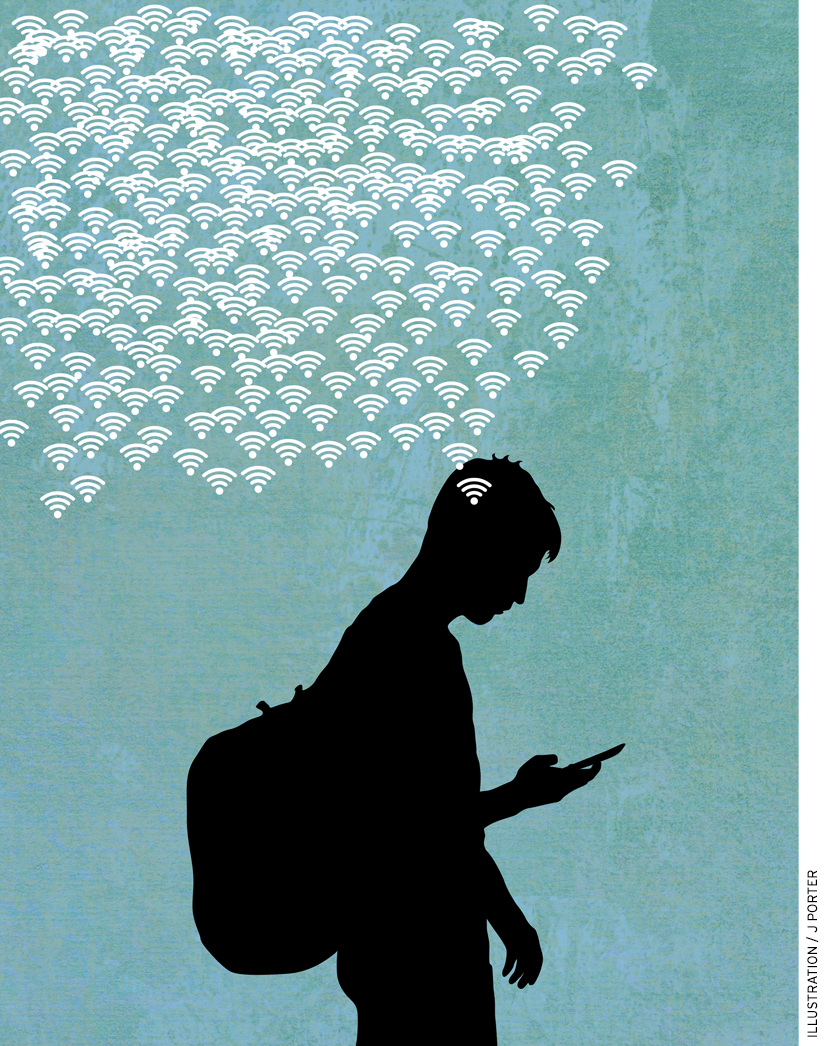 Since the early 2000s, when wireless connectivity and the Internet evolved into everyday technologies, they have come to pervade our home and work lives, revolutionizing the way we share and access information. Wi-Fi circuits, which connect a device to a wireless network and the Internet, are incorporated into billions of devices, ranging from bathroom scales and “smart” electric outlets to equipment that streams movies and music. Wi-Fi is installed on our smartphones and laptops, at home and in the workplace, in cafés and airports, and of course, in schools everywhere.
Since the early 2000s, when wireless connectivity and the Internet evolved into everyday technologies, they have come to pervade our home and work lives, revolutionizing the way we share and access information. Wi-Fi circuits, which connect a device to a wireless network and the Internet, are incorporated into billions of devices, ranging from bathroom scales and “smart” electric outlets to equipment that streams movies and music. Wi-Fi is installed on our smartphones and laptops, at home and in the workplace, in cafés and airports, and of course, in schools everywhere.
Digital learning and wireless connectivity have become so entrenched in schools that many educators now consider high-speed Internet access a requirement for effective teaching. The federal government, via the Federal Communications Commission, subsidizes wireless connectivity and other technology in schools through its E-rate program. Advocates aspire to equip every student in America with wireless access, and the organization EducationSuperHighway estimates that as of 2017, 88 percent of schools had robust Wi-Fi capability in their classrooms, up from 25 percent just four years earlier (see Figure 1). Some school districts are providing Wi-Fi access to places like football fields and school buses to help students without reliable Internet access at home complete and submit assignments.
But schools are finding that a substantial number of people have health concerns about the radio frequency, or RF, signals emitted by Wi-Fi devices, even as exposure levels are far below government safety limits. Objectors have banded together to protest what they consider to be the health hazards of wireless technologies, including Wi-Fi in schools. The 2018 documentary Generation Zapped chronicled the efforts of key players in this campaign, who blame RF exposures from low-level sources such as Wi-Fi for a host of detrimental health effects, from headaches and hearing loss to Alzheimer’s and brain cancer. Some scientists and physicians support their views (even though they might not agree on just what those adverse health effects might be), and the issue has been taken up by alternative-medicine proponents such as the physician Joseph Mercola (better known for his anti-vaccine advocacy).
While digital culture has brought great benefits, it has certainly had negative consequences as well—such as loss of privacy, disruptive hacking, and harms to children from misuse of cell phones. But need we worry about the health risks of environmental exposure to radio frequency energy? The evidence we have accumulated so far would suggest not. National health agencies have credibly concluded that no adverse health effects have been demonstrated at radio frequency exposures that fall within established safety guidelines—and the exposures from Wi-Fi fall well below those limits.
Yet a substantial number of people do worry about exposure to RF energy in the environment. In 2017, noted risk expert Peter Wiedemann, then at the University of Wollongong in Australia, reported on a survey of 2,454 people in six European countries about their concerns over electromagnetic-field exposure. The investigators found that 40 percent of the respondents had some concerns, with 12 percent describing themselves as “enduringly concerned”—that is, frequently thinking and talking about electromagnetic-field exposure. Most of their worries were related to radio frequency sources. Cell towers, Wi-Fi, wireless-enabled electric utility meters, and other sources of “involuntary” exposure were noted as particularly troubling. Numerous websites serve as echo chambers for these apprehensions, offering alarming interpretations of scientific developments. Some of the sites sell RF-shielding garments or provide templates of letters for concerned individuals to send to political leaders.
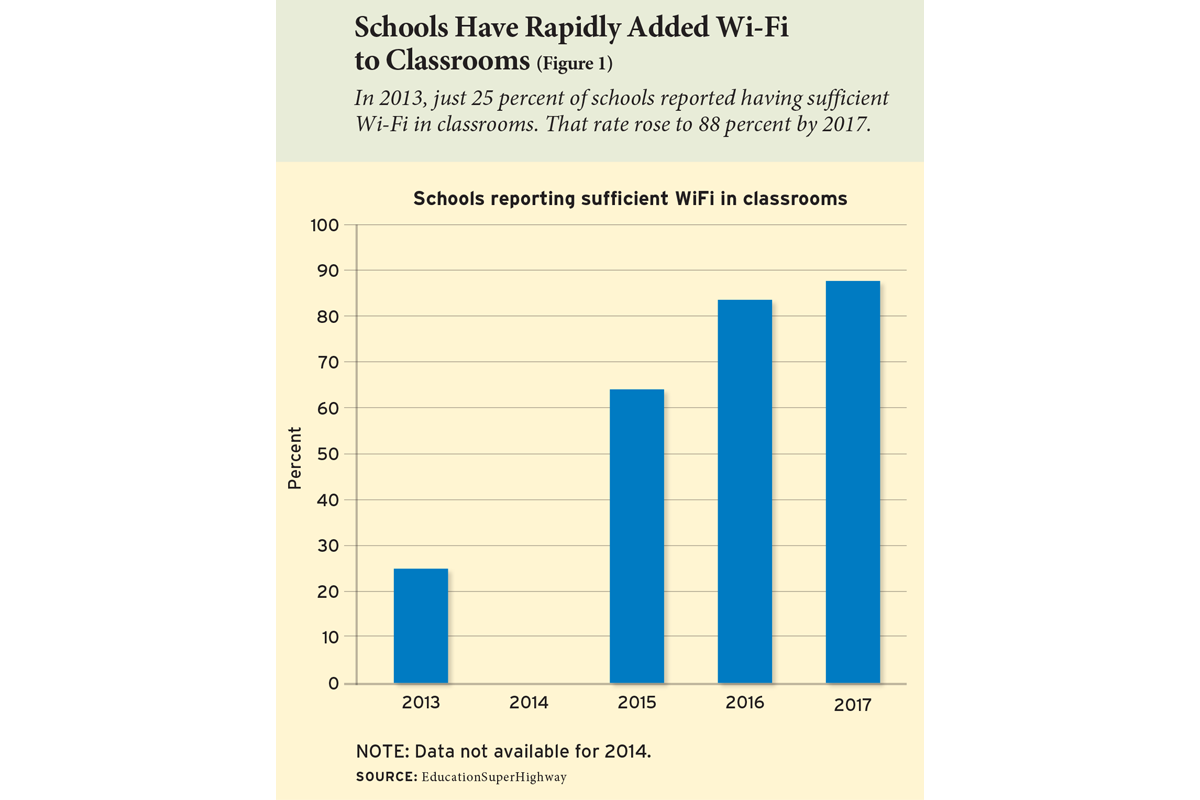
The Science behind RF Energy
With any potentially hazardous agent, the dose makes the poison. At high exposure levels, radio frequency energy can indeed be hazardous, producing burns or other thermal damage, but these exposures are typically incurred only in occupational settings near high-powered RF transmitters, or sometimes in medical procedures gone awry. Two fundamental questions about any health risk are: what kinds of adverse effects may possibly occur under given exposure levels, and how much exposure do people actually receive in the real world?
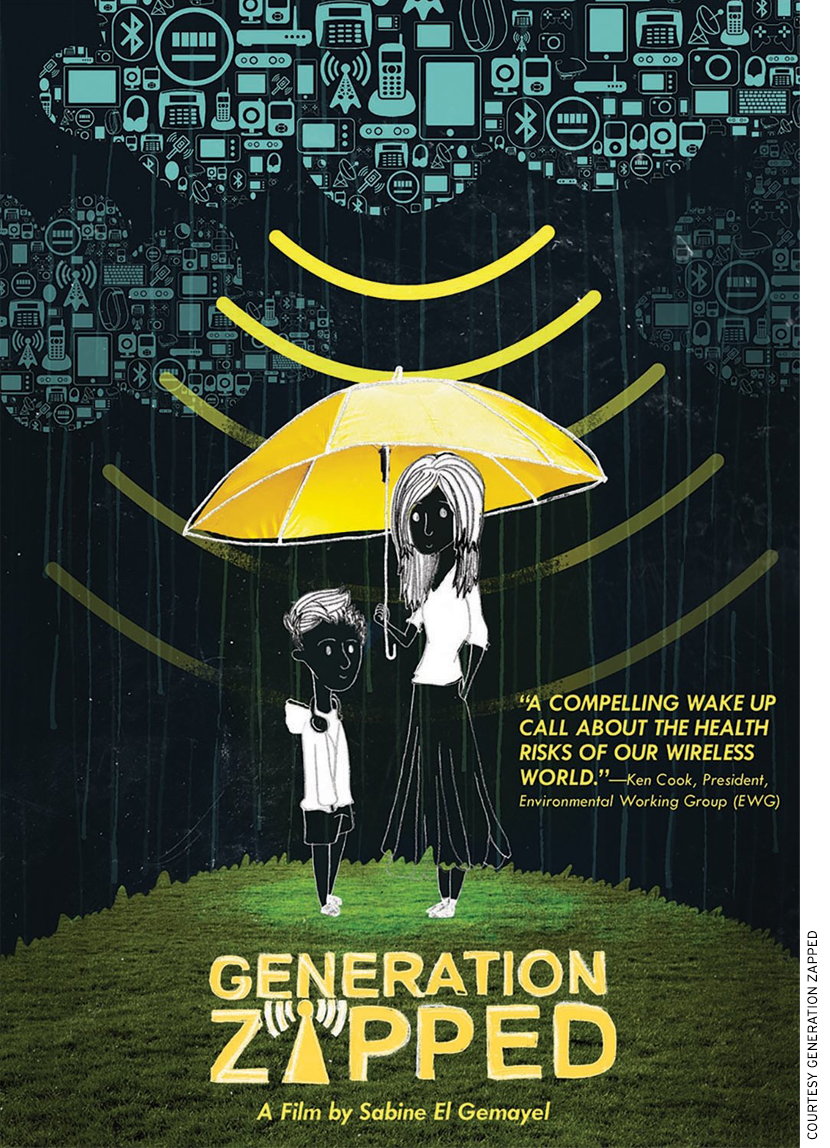
The very word “radiation” is scary to many people, who may associate it with overexposure to x-rays, or the cancers induced by massive exposures during the 1986 Chernobyl nuclear accident. But, technically speaking, radiation is simply energy moving through space. Thus, even light from a flashlight is a form of radiation. Radio frequency energy transmitted from an antenna is also a form of radiation, but unlike x-rays and other forms of potentially dangerous radiation, RF energy is non-ionizing: that is, the photons that carry the signal do not have enough energy to disrupt molecules in the body to form free radicals, which can damage cells and tissues. RF energy has nothing in common with ionizing radiation in terms of potential health effects. The term electromagnetic field, or EMF, refers to electromagnetic energy in general, regardless of frequency. In health discussions, the term is used broadly to refer to any part of the electromagnetic spectrum, most typically to power-line fields (at 50 or 60 hertz) or radio frequency fields.
“Wi-Fi” does not refer to any specific physical agent, but rather is a trademarked name for devices that conform to a set of engineering standards that enable them to communicate through wireless links. Currently, Wi-Fi devices transmit in two bands of the radio frequency spectrum, near 2.45 and 5 gigahertz, but additional frequency bands will be used in the future. The lower frequency range is part of the industrial, scientific, and medical band that has long been used by household microwave ovens, diathermy and other medical equipment, industrial heaters, and many other devices. Wi-Fi operates in the microwave part of the spectrum (300 megahertz to 300 gigahertz). Nearly the entire microwave region of the spectrum is used for something—cell phones, broadcast applications, radar, industrial heating equipment, and, since the late 1990s, a vast number of low-powered communications devices, of which Wi-Fi is only one of several classes.
A Wi-Fi network (technically called a wireless local-area network) is configured around sets of low-powered RF transmitters. Access points, which in schools are typically mounted high on walls or above ceiling tiles, allow Wi-Fi-enabled devices (called clients) to connect to the network and access the Internet. In a school, these devices would include laptops, tablet computers, and often printers and audiovisual equipment in classrooms.
Wi-Fi devices transmit streams of brief radio frequency pulses at somewhat lower peak power levels than those used by cell phones, and at a very low-duty cycle (fraction of time spent transmitting). Only one device can transmit at a time on a Wi-Fi network. If the network is operating at full capacity (an unusual situation, even in a classroom of students accessing the network), the total amount of RF energy transmitted on the network might be roughly comparable to that from a single cell phone in use in the room or to the small amounts of microwave energy that typically leak from the front door of a kitchen microwave oven while in use. These signals come, in turn, from every device that is connected to the network, most of which are located at some distance from any given individual in the room.
Individuals who are in the vicinity of a Wi-Fi network are exposed to radio frequency signals in two ways: from the typically weak signals in the network and also from the generally stronger but more intermittent signals coming from RF transmitters (such as Wi-Fi, Bluetooth, and cell phone antennas) in the user’s own device. Any wireless device that is legally sold in the United States must be authorized by the Federal Communications Commission, which requires appropriate testing by manufacturers to document compliance with the commission’s safety limits. Those regulatory thresholds are far below any demonstrably hazardous exposure level that could cause excessive heating of tissue, which cannot happen with low-powered Wi-Fi equipment.
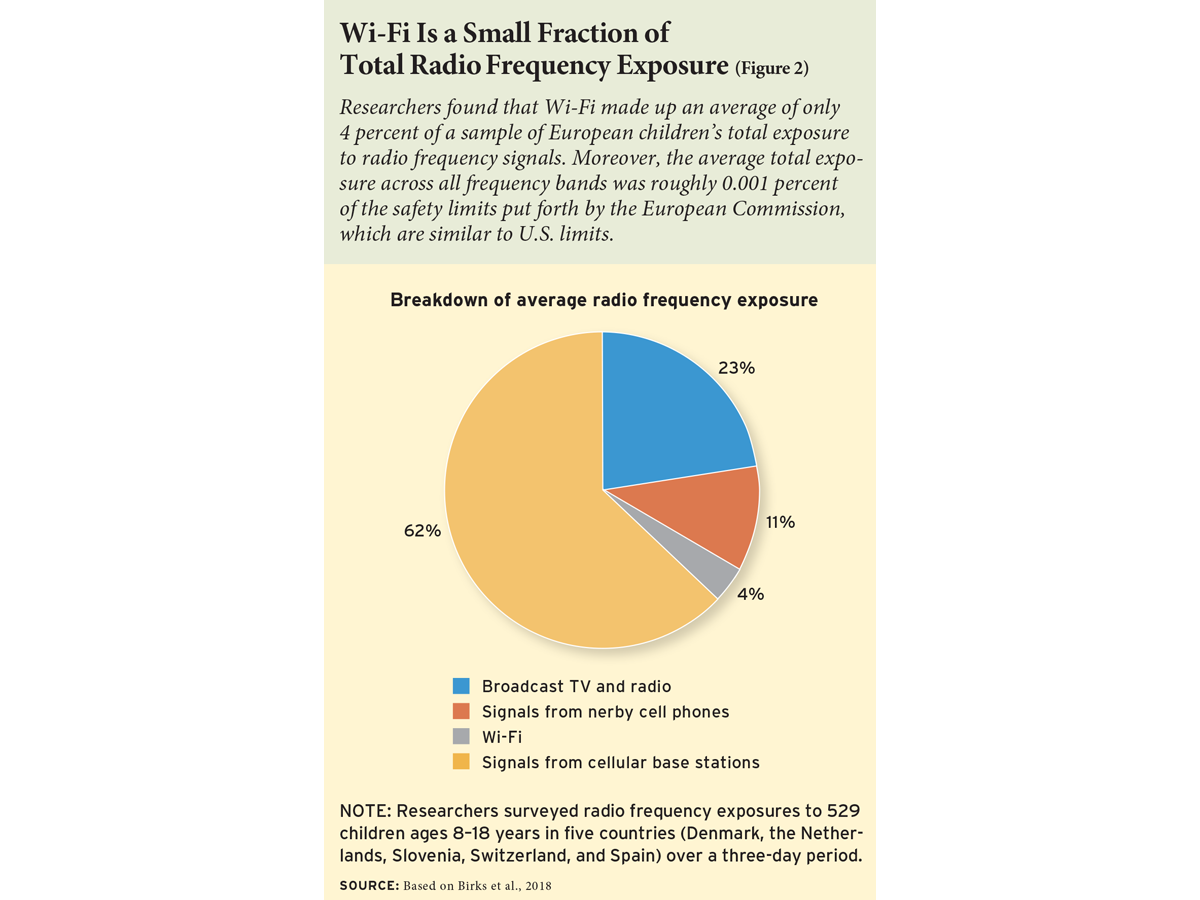
Exposure in Schools
Numerous surveys have examined levels of exposure to the population from environmental sources of radio frequency energy. While these levels vary greatly, the largest exposure an individual generally incurs is from use of a cell phone. Below that level are signals from cell phones operated in the person’s vicinity. Still lower, on average, are signals from many other sources in the environment: cell towers, broadcast and communications transmitters outside the home, and microwave ovens, wireless baby monitors, cordless phones, Wi-Fi, and other RF-emitting devices within the home. The cumulative exposure from all sources in ordinary environments is invariably a tiny fraction of established safety limits. Those limits are designed to provide adequate protection against all established hazards from radio frequency energy over any duration of exposure.
Two studies illustrate the exposure levels involved. In 2017, Lena Hedendahl and colleagues in Sweden fitted 18 teachers in seven schools with instruments that recorded exposure from multiple RF sources many times a day for entire school days. The average RF exposures to the teachers from Wi-Fi in school were comparable to that from sources outside the school (chiefly, for those schools, “downlink” signals from nearby cellular base station antennas, which are the yard-long antennas seen today on many rooftops) and considerably below “uplink” signals from cell phones in the teachers’ vicinity. All exposure levels were a tiny fraction of U.S. and European safety limits.
More recently, a large multinational group of investigators led by Elisabeth Cardis of the University of Barcelona surveyed radio frequency exposures to 529 children ages 8 to 18 living in five countries (Denmark, the Netherlands, Slovenia, Switzerland, and Spain). The investigators fitted the kids with personal RF dosimeters that recorded their exposures from a variety of sources in and out of school for up to three days. Consistent with other studies, Wi-Fi amounted to only a small fraction of the children’s total RF exposure (see Figure 2). RF exposures in the schools, the study found, were generally comparable to or lower than those in other environments: 95 percent of the children had Wi-Fi at home, and three quarters of them used cell phones, with more than one third of the students accessing the Internet via cell phones for more than 30 minutes a day.
The overall conclusion from these and other surveys is that exposures to radio frequency signals from Wi-Fi are far below accepted safety limits, and generally lower than exposures from other RF sources in the environment. And while our environment is awash with radio frequency energy, Wi-Fi is only a small part of the total picture.
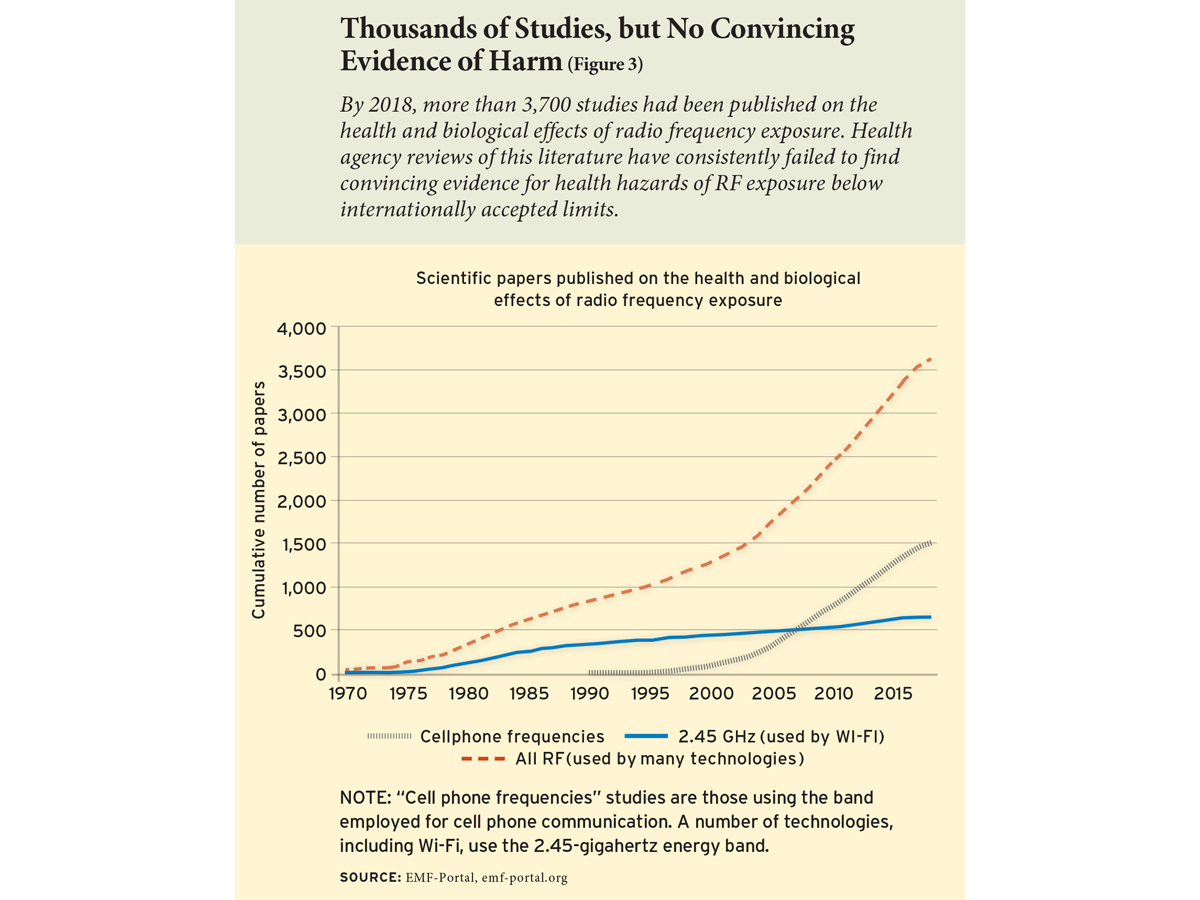
Research on Health Effects
Spurred in part by public concerns, many studies on radio frequency exposure—nearly 4,000 to date—have been done over the past half century. From the beginning, a large share of these studies used radio frequency energy in the industrial, scientific, and medical band in which Wi-Fi operates (see Figure 3), in part to address occupational health concerns from the use of high-powered microwave sources. More recently, starting in the mid-1990s, many additional studies have investigated RF exposures at cell phone frequencies (typically, 800–1950 megahertz). A small but growing number of studies have considered RF exposures from Wi-Fi signals.
The studies vary widely in quality and approach. A comparatively few studies have used standard protocols and exacting quality standards, as a drug or chemical company would in assessing the safety of a product. Such rigorous studies are expensive undertakings because they require large numbers of subjects, exacting methodology, and sophisticated engineering to produce well-defined RF exposures.
The great majority of these studies, though, are not standard risk-assessment investigations. A large share of them are smaller, often exploratory studies that vary greatly in quality, in the endpoint they investigate, and in their relevance to health. Many are one-of-a-kind studies, not replicated even in the investigators’ own labs, and many have used RF exposures well above safety limits, where heating of the sample may have produced effects. A large proportion have serious methodological problems, such as inadequate assessment of exposure levels or a lack of appropriate controls, both of which prevent reliable interpretation of the results.
While many of the studies—particularly the better-designed ones—reported no statistically significant effects of exposure apart from those caused by heating, many others have reported impacts of some sort that the authors did not consider to be thermal in origin. This vast literature shows clearly that excessive exposure is dangerous because of heating, but it also contains a wealth of often contradictory reports of small effects with no clear health significance. There have been too many fishing expeditions in this field.
In reviews of this literature, health agencies have generally applied a systematic approach, using panels of professional scientists and engineers to examine all relevant studies according to defined protocols. These reviews aim to be comprehensive, acknowledging but giving little weight to studies with obvious methodological deficiencies. In addition, the panels look for consistencies in the evidence across studies, and are reluctant to draw conclusions from one-off exploratory studies in the absence of other supporting evidence for specific conclusions. Anti-Wi-Fi campaigners, for their part, seem inclined to cherry-pick the literature and compile lists of studies that support their views, regardless of methodological quality.
High-quality reviews by health agencies run to the hundreds of pages of highly technical discussion. They have consistently failed to find convincing evidence for health hazards of radio frequency exposure that falls below internationally accepted limits. But they also point to gaps in knowledge and call for more research.
In France, for example, the Agency for Food, Environmental and Occupational Health & Safety has extensively reviewed the issue of radio frequency exposure and health. In its most recent review, 16 independent experts worked for three years, holding multiple meetings and public consultations. The final report, issued in 2013, concluded that “no available data makes it possible to propose new exposure limit values for the general population,” but it listed a number of questions needing further study.
In 2016, the same French agency issued an opinion on RF exposures to children age six and under who (the review pointed out) are exposed to such signals from a number of sources, including remote-controlled toys, walkie-talkies, and cell phones. The opinion considered evidence on nine different health-related endpoints, ranging from behavior and cognitive effects to toxicity to various body systems. The committee found that the available data for seven of these endpoints were insufficient to establish effects (either beneficial or adverse) from RF exposure. The committee found “limited evidence” for effects of cell phone use on cognitive function and general well-being, adding that “these effects may however be linked to the use of the mobile telephones rather than to the frequencies they emit.” The opinion mentions Wi-Fi only once, in passing.
Claims of Harm
In contrast to the cautious but generally reassuring findings of health agencies, those who oppose Wi-Fi argue that radio frequency exposures are hazardous to human health, even at exposure levels far below international limits. Their basic argument, which is appealing to many laypersons but not persuasive scientifically, is that the many reported bioeffects of RF energy mean that Wi-Fi fields must have some health effect, even though we cannot discern it clearly.
Undoubtedly the most widely cited document supporting this position is the BioInitiative Report, a nearly 1,500-page review of research on the biological effects of electromagnetic fields over wide ranges of exposure, compiled by a group of self-selected authors. Unlike the health agencies that sponsor the critical reviews, the report’s editors made little attempt to assess the methodological quality of the studies they discussed or evaluate the consistency of findings of different studies with similar endpoints. The report shows strong confirmation bias—paying more attention to studies reporting biological effects than to other, possibly stronger, studies finding no effects.
In a concluding chapter, the editors proposed a “precautionary action level” for radio frequency exposure that is a tiny fraction of existing international limits—less than one millionth of the current limits set by the Federal Communications Commission. The limit recommended by the report, if applied consistently, would effectively rule out any application of RF energy transmitted where people are present—not only Wi-Fi but also cell phones, broadcast television and radio, radar, and even emergency police communications.
The BioInitiative Report has been widely criticized by health agencies and other expert groups for its lack of balance. Nevertheless, it is often cited by those who campaign against the installation of cell phone towers, electric utility meters, power lines, and other electrical infrastructure. Its alarmist perspective is echoed in a number of statements by self-selected groups, such as the 2017 “Reykjavik Appeal,” which arose from a conference on “children, screen time, and wireless radiation” and urged schools to forbid cell phone use and to install hard-wired connections instead of Wi-Fi.
Two health issues dominate current arguments by Wi-Fi opponents. One is that Wi-Fi exposures might lead to cancer. This derives from a 2013 study by the International Agency for Research on Cancer (IARC), a component of the World Health Organization that conducts highly regarded reviews of suspected human carcinogens. The study concluded that there was “limited evidence” from human or animal studies for carcinogenic effects of RF radiation, and it classified RF electromagnetic fields as “possibly carcinogenic” to humans. In the agency’s specialized terminology, this designation indicates that the available evidence was sufficient to raise suspicions, but insufficient for the working group to conclude that a causal relationship “probably” or actually does exist. (The agency’s strongest classification is “carcinogenic to humans,” followed by “probably carcinogenic”; “possibly carcinogenic”; “not classifiable as carcinogenic”; and “probably not carcinogenic.”)
While the agency’s “possibly carcinogenic” classification for radio frequency energy has drawn wide attention, it has been frequently misunderstood by the public. “IARC is an international agency for cancer research, not a public health agency,” noted Peter Wiedemann in a 2014 paper. “Therefore, the categorizations made regarding human carcinogens were not supposed to be interpreted as public health messages, as they have been used recently.” As a group of senior scientists associated with the panel wrote in their 2015 review, European Code Against Cancer, “radiofrequency electromagnetic fields are not an established cause of cancer and are therefore not addressed in the recommendations to reduce cancer risk.”
In short, IARC’s “possible” classification for RF fields does not tell us about the actual health risks, if any, from RF exposures, nor is it a recommendation for public policy. It points to the need for more research, which should focus on stronger sources of RF exposure than Wi-Fi.
The second health issue raised by those opposed to RF exposure is “electromagnetic hypersensitivity,” a syndrome marked by non-specific symptoms such as headache, sleep problems, and anxiety, which many people attribute to low-level radio frequency fields. There is no doubt that many of these individuals have serious health problems; their symptoms are genuine. However, many well-controlled studies have failed to link electromagnetic-field exposure of any kind to these symptoms. In blinded and controlled tests, electromagnetically “sensitive” individuals typically report symptoms when they think they are exposed to electromagnetic-field energy, not necessarily when they demonstrably are exposed. According to the World Health Organization, the condition “has no clear diagnostic criteria and there is no basis to link” electromagnetic hypersensitivity symptoms to electromagnetic-field exposure. The agency said electromagnetic hypersensitivity “is not a medical diagnosis, nor is it clear that it represents a single medical problem.”

Better Safe Than Sorry?
The Environmental Health Trust, an advocacy group concerned about the health effects of radio frequency fields, has published a list of dozens of actions taken by governments, health authorities, and schools around the world intended “to reduce radiofrequency radiation exposures.”
The list, though, is a mixed bag that includes policies that are not principally aimed at reducing radio frequency exposure. It cites a statement by the Canadian Paediatric Society, for example, that aims to promote physical activity in children. The statement encourages less sedentary time and screen time but says nothing about RF exposure. And policies on the list aimed to limit use of wireless communications in schools have a variety of goals. In 2018, when the French legislature banned the use of cell phones and tablets in schools by children age 15 and under, the aim was indeed to “protect children and adolescents,” according to Jean-Michel Blanquer, minister of education—but not from RF exposure. “We know today that there is a phenomenon of screen addiction, the phenomenon of bad mobile-phone use,” Blanquer told a French news channel. (Since nearly every French student has a cell phone, one wonders how French teachers will manage to enforce the ban.)
France has also banned the marketing of child-friendly cell phones to children under six, and using wireless devices in daycare centers and nurseries for children under three. The country allows Wi-Fi to be used in primary schools, but requires that Wi-Fi networks be deactivated except when they are used for educational activities.
The Environmental Health Trust lists a number of schools around the world, including some in the United States, that have removed Wi-Fi and reverted to hard-wired Ethernet connections for Internet access. (The inventory includes some Waldorf and Montessori schools for young children, which would seem to have little to lose by forgoing Wi-Fi in any event.) The list contains a miscellany of other actions, such as an order by the mayor of a small Italian town to shut off Wi-Fi in the community’s two schools because of health concerns. “Who knows?” the mayor said to the daily newspaper La Stampa. “In 20 years, some people might thank us for it.” But the action was opposed by some parents and other town leaders. “What’s the point?” a former mayor said, observing that there was already Wi-Fi in several other places around town, including the library, where children spent a lot of time.
The town’s order, as well as most of the other actions in the Environmental Health Trust’s list, are precautionary, that is, predicated on the notion of “better safe than sorry” rather than on any identified hazards of wireless communications.
An influential 2000 commentary by the European Commission, the governing body of the European Union, defined how the “precautionary principle” should be used. The commission indicated that the principle should only be invoked after a health hazard is identified, after “as complete as possible” an analysis of the relevant scientific evidence is conducted, and after the probable costs and benefits of precautionary policies is assessed. It noted that a wide range of “precautionary” policies could be adopted, from simply keeping track of scientific developments to outright bans on a technology. There is little sign that officials conducted that kind of analysis before instituting the measures listed by the Environmental Health Trust. They may well have been political accommodations to a concerned public rather than carefully considered health measures.
The precautionary principle has little standing in U.S. and Canadian law. Health agencies in the two countries generally refrain from offering health advice unless substantial scientific evidence supports it. For example, in October 2017, Health Canada advised, in response to a petition from a parents’ group in Peel, Ontario, that:
It is Health Canada’s position, based on the latest scientific evidence, that exposure to low-level RF energy, including that from Wi-Fi technology, is not dangerous to the public if the recommended exposure limits in Safety Code 6 [Canadian RF exposure limits, which are generally similar to U.S. limits] are respected. Accordingly, no additional precautionary measures are required, since RF energy exposure levels from Wi-Fi are typically well below Canadian and international safety limits. Internationally, while a few jurisdictions (cities, provinces or countries) have applied more restrictive limits for RF field exposures from certain wireless devices/apparatus (whether it be Wi-Fi or cell towers), scientific evidence does not support the need for such restrictive limits.
On its website, the Peel District School Board described its consultations with “trusted medical experts” and measurements by a consultant that showed that radio frequency exposures from Wi-Fi in its classrooms were far below Canadian limits. This approach makes sense; school officials are not capable of adjudicating complex scientific issues, nor should they be asked to.
Inevitably, some schools will have to address concerns of staff or parents of children with perceived electromagnetic hypersensitivity. Following recommendations of the World Health Organization, individuals reporting electromagnetic hypersensitivity should be referred to health professionals for assistance without the assumption that their symptoms are directly caused by electromagnetic-field exposure. Schools should be wary of requests to provide “radiation free” environments. Given the many sources of exposure that “hypersensitive” individuals cite as causes of their symptoms—compact LED and fluorescent light bulbs, electric light dimmers, Wi-Fi devices, cell phones, cell towers outside the building—trying to produce a “radiation free” environment could be highly disruptive to schools; achieving it would also be impossible, if “radiation free” means a total lack of RF signals in the environment. And, in the absence of a demonstrated link between exposure to electromagnetic fields and the symptoms that some individuals experience, there is no way to identify an exposure level that is low enough not to “cause” symptoms.
The Internet and wireless communications do present risks that schools need to manage. It would not do, for example, for Johnny to be touching up his Facebook page (or worse) during class or sending inappropriate photos to his classmates. Wireless networks and wireless-connected devices are susceptible to hacking and other cybercrimes with potentially significant impact to schools. Schools need to adopt appropriate policies for safe use of cell phones and the Internet by children—not because of unproven radiation hazards but to avoid the harms that these otherwise highly useful technologies can pose. If health agencies eventually conclude that radio frequency signals from Wi-Fi are hazardous in some way, schools can revise their policies accordingly. In light of half a century of research on the biological effects of radio frequency energy, such a conclusion seems unlikely.
Kenneth R. Foster is professor emeritus of bioengineering at the University of Pennsylvania and an engineering consultant to government and industry. In 2012 he participated in a review of the literature related to health effects of Wi-Fi for the Wi-Fi Alliance, an industry group.
This article appeared in the Summer 2019 issue of Education Next. Suggested citation format:
Foster, K.R. (2019). Is Wi-Fi a Health Threat in Schools? Sorting fact from fiction. Education Next, 19(3), 28-36.


